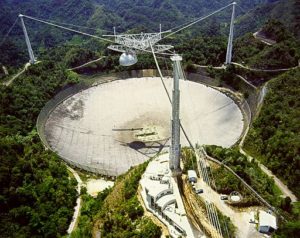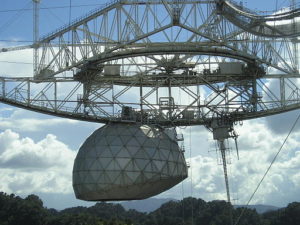Puerto Rico’s Arecibo Radiotelescope was the second observatory to see a Fast Radio Burst.

Image attribution: By H. Schweiker/WIYN and NOAO/AURA/NSF, Wikimedia Commons

Closeup of the focusing mechanism of the Arecibo telescope.
Image attribution: By Alessandro Cai (OliverZena) (own work) via Wikimedia Commons
The above photographers note that the Arecibo Radio Telescope dish is built into a bowl in the landscape. It focuses radio waves from the sky on the feed antenna suspended above it on cables (see close-up image above). Since the dish itself can’t move, the telescope is steered to point at different regions of the sky by moving the feed antenna (dome) along the curving metal track.
The Arecibo Observatory has captured one of the most fleeting, mysterious and rare deep-space events – a so-called “fast radio burst” (FRB) that lasted a mere three one-thousandths of a second. Cornell, McGill University and other astronomers report this peculiar [2012] event today (July 10, 2014) in the Astrophysical Journal.
Until now, the Parkes Radio Telescope in New South Wales, Australia, had discovered all five previously known FRBs. This breakneck burst was found Nov. 2, 2012, and not formally reported until this paper, as astronomers needed to verify its authenticity and to rule out cosmic noise.
“It was a single pulse – additional observations of the same direction on the sky have shown nothing,” said James Cordes, Cornell professor of astronomy and an author on the paper. “The nature of these bursts had been in doubt until recently, and the discovery at Arecibo cements the case that they are astrophysical, rather than some unique form of radio interference at Parkes.”
Like a gigantic ear attentive to the heavens, the Arecibo Observatory in Puerto Rico is Earth’s largest single-aperture radio telescope, tuned to find pulsars, galaxies, objects in the solar system and even the Earth’s ionosphere. It’s so large that the height of the Empire State Building fits in its diameter, and the Washington Monument fits in the dish’s focal point.
To read the details of this article published in 2014, see the story at news.cornell.edu
Visit the next page to see how an early warning system was developed in New South Wales to respond to any further Fast Radio Burstsl
